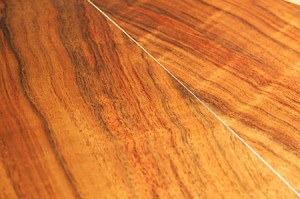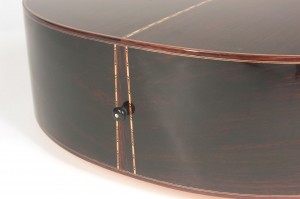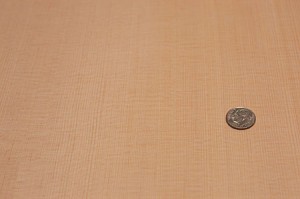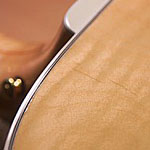 Search out any discussion about tone and tonewoods on the internet and you will quickly find a wide variation of opinions among players and builders alike. However, the majority will almost always list “tonewoods” and/or specific species of Spruce and Cedar as the key to getting the desired tone from a guitar. Indeed, many beginning builders agonize over wood choice combinations as they relate to tone, with more experienced craftspeople offering suggestions that seem to assure the correct outcome will result if the recipe is followed.
Search out any discussion about tone and tonewoods on the internet and you will quickly find a wide variation of opinions among players and builders alike. However, the majority will almost always list “tonewoods” and/or specific species of Spruce and Cedar as the key to getting the desired tone from a guitar. Indeed, many beginning builders agonize over wood choice combinations as they relate to tone, with more experienced craftspeople offering suggestions that seem to assure the correct outcome will result if the recipe is followed.
To be sure, most of the hardwoods commonly used in guitar building have an associated ‘voice’ that affects the tone of the instrument to some degree. These include members of the Rosewood and Mahogany families, along with Maple, Koa, Walnut, Myrtle, and a few others. Builders are also using more exotic woods these days such as Zebrawood, Purpleheart, Bloodwood, Bubinga, and Ziricote. Differences in density and other structural characteristics of each species will contribute to the overall tone of the instrument.
 But just how much does back and side wood choice affect tone? Is there a magic “tonewood” that, by itself, makes a guitar come alive with rich sound? Does choosing one tonewood over another greatly impact the voice of a guitar? The short answer is no. This statement flies in the face of conventional thinking and the idea has been so reinforced by repetition that is almost heretical to suggest otherwise. But the variables that impact tone may have less to do with wood species choice than most players and even many builders assume. Even Brazilian Rosewood, long esteemed to be the holy grail of tonewoods, can’t produce superior tone by itself, and may in fact enjoy an exaggerated reputation simply because it was used extensively on guitars in decades past. Some of these old guitars sound exceptional, with the resulting assumptions made about why they do sound so great. But Brazilian Rosewood was used to make cheap, mediocre sounding guitars during that era too!
But just how much does back and side wood choice affect tone? Is there a magic “tonewood” that, by itself, makes a guitar come alive with rich sound? Does choosing one tonewood over another greatly impact the voice of a guitar? The short answer is no. This statement flies in the face of conventional thinking and the idea has been so reinforced by repetition that is almost heretical to suggest otherwise. But the variables that impact tone may have less to do with wood species choice than most players and even many builders assume. Even Brazilian Rosewood, long esteemed to be the holy grail of tonewoods, can’t produce superior tone by itself, and may in fact enjoy an exaggerated reputation simply because it was used extensively on guitars in decades past. Some of these old guitars sound exceptional, with the resulting assumptions made about why they do sound so great. But Brazilian Rosewood was used to make cheap, mediocre sounding guitars during that era too!
Adding to the mythology of guitar tonewoods is the hype that is often included in the advertising copy of factory made instruments. And of course, if the claim is made by a famous brand in a glossy brochure or magazine ad, then of course it must be true, right? As an example of this, I recently saw an advertisement for a certain well-known brand of guitar that expounded the amazing tonal qualities of Myrtle wood. Myrtle, according to this ad, is infused with magical and sparkling tonal qualities by nature of the rugged terrain and clear mountain air where it grows. Myrtle, it is claimed by this maker, captures every element of tone from all the best species ever used to make acoustic guitars. Now, I love Myrtle and you can find photographs on this web site of guitars I have made using this fine wood. But the claims of the magazine ad are, to be blunt, nonsense. Myrtle sounds much like most other woods commonly used to build guitars, and other factors beside the species of back and side wood have much more influence on tone.
It is important to understand that choosing a specific wood is only one part of the total spectrum of design considerations that affect tone. Body size and shape, brace sculpting, neck and fretboard materials, wood thickness, action, string gauge, and playing ability all affect tone in varying degrees. Beyond all of these, the material properties of the top wood has an enormous impact on the sound of a guitar. These properties are much more important than which species of Spruce is used, more important than the selection of back and side wood, and more important than scalloped braces. Choosing the right piece of Spruce, thinning it to the correct deflection, and tuning it during brace carving to a specific fundamental resonance leads to great tone. For more information please see the article Voicing and Tap Tuning.

What does this mean to the tone connoisseur? Well, there is a lot more to getting great tone from a guitar than simply selecting the perfect “tonewood” for the back and sides. In reality, there is no magic wood… not even the coveted Brazilian Rosewood will make a mediocre spruce top or a poorly made instrument sound exceptional. In the end, it is what each person’s ears and eyes tell them about a specific wood or guitar that makes it right for them. I always suggest that my customers consider the appearance of the back and side woods as well as any perceived tonal variations among them. Choose the wood that appeals to your eye and ear. Above all, try to avoid bias and presuppositions when listening to different guitars, and evaluate the tone and voice of the instrument with a critical ear. Balance and clarity are the hallmarks of a great sounding guitar.

